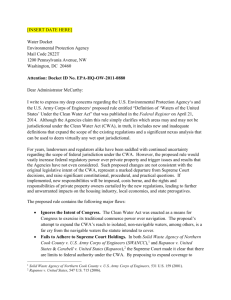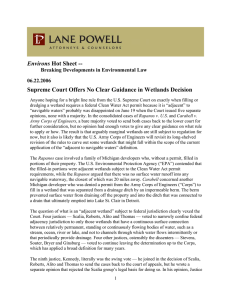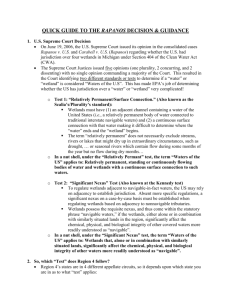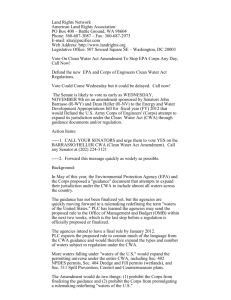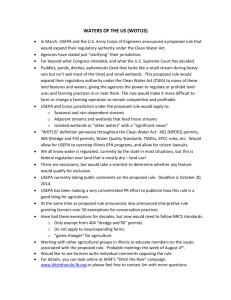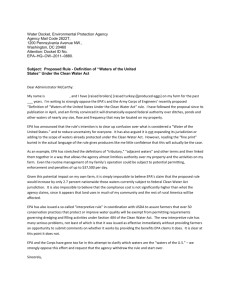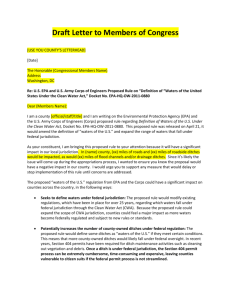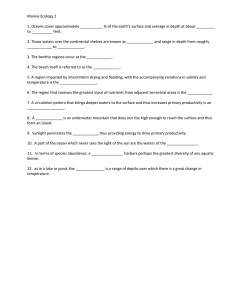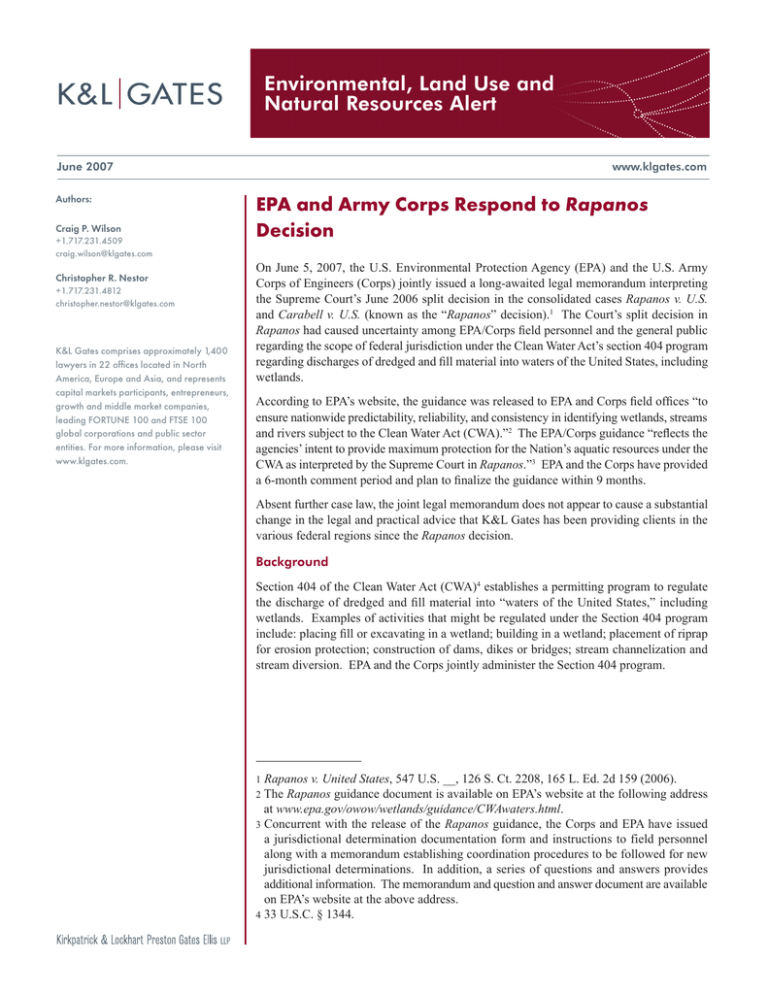
Environmental, Land Use and
Natural Resources Alert
June 2007
Authors:
Craig P. Wilson
+1.717.231.4509
craig.wilson@klgates.com
Christopher R. Nestor
+1.717.231.4812
christopher.nestor@klgates.com
K&L Gates comprises approximately 1,400
lawyers in 22 offices located in North
America, Europe and Asia, and represents
capital markets participants, entrepreneurs,
growth and middle market companies,
leading FORTUNE 100 and FTSE 100
global corporations and public sector
entities. For more information, please visit
www.klgates.com.
www.klgates.com
EPa and Army Corps Respond to Rapanos
Decision
On June 5, 2007, the U.S. Environmental Protection Agency (EPA) and the U.S. Army
Corps of Engineers (Corps) jointly issued a long-awaited legal memorandum interpreting
the Supreme Court’s June 2006 split decision in the consolidated cases Rapanos v. U.S.
and Carabell v. U.S. (known as the “Rapanos” decision). The Court’s split decision in
Rapanos had caused uncertainty among EPA/Corps field personnel and the general public
regarding the scope of federal jurisdiction under the Clean Water Act’s section 404 program
regarding discharges of dredged and fill material into waters of the United States, including
wetlands.
According to EPA’s website, the guidance was released to EPA and Corps field offices “to
ensure nationwide predictability, reliability, and consistency in identifying wetlands, streams
and rivers subject to the Clean Water Act (CWA).” The EPA/Corps guidance “reflects the
agencies’ intent to provide maximum protection for the Nation’s aquatic resources under the
CWA as interpreted by the Supreme Court in Rapanos.” EPA and the Corps have provided
a 6-month comment period and plan to finalize the guidance within 9 months.
Absent further case law, the joint legal memorandum does not appear to cause a substantial
change in the legal and practical advice that K&L Gates has been providing clients in the
various federal regions since the Rapanos decision.
Background
Section 404 of the Clean Water Act (CWA) establishes a permitting program to regulate
the discharge of dredged and fill material into “waters of the United States,” including
wetlands. Examples of activities that might be regulated under the Section 404 program
include: placing fill or excavating in a wetland; building in a wetland; placement of riprap
for erosion protection; construction of dams, dikes or bridges; stream channelization and
stream diversion. EPA and the Corps jointly administer the Section 404 program.
Rapanos v. United States, 547 U.S. __, 126 S. Ct. 2208, 165 L. Ed. 2d 159 (2006).
The Rapanos guidance document is available on EPA’s website at the following address
at www.epa.gov/owow/wetlands/guidance/CWAwaters.html.
Concurrent with the release of the Rapanos guidance, the Corps and EPA have issued
a jurisdictional determination documentation form and instructions to field personnel
along with a memorandum establishing coordination procedures to be followed for new
jurisdictional determinations. In addition, a series of questions and answers provides
additional information. The memorandum and question and answer document are available
on EPA’s website at the above address.
33 U.S.C. § 1344.
Environmental, Land Use and
Natural Resouces Alert
In Rapanos, the Supreme Court addressed the scope and
extent of CWA Section 404 jurisdiction over “waters
of the United States” including “wetlands.” The
Court vacated lower court decisions that had broadly
interpreted this term to include any area where water
existed and ultimately could flow to a truly navigable
water, regardless of how minimal the connection. The
Rapanos decision, however, created uncertainty as
to the precise limits of federal regulatory jurisdiction
under the CWA, both for purposes of wetland regulation
and broader water quality regulation. In a 4-1-4 split
decision, a plurality of four justices concluded that
federal jurisdiction should not attach to a wetland
unless (1) the adjacent channel contains a water of the
United States (i.e., a relatively permanent water body
connected to traditional interstate, navigable waters),
and (2) the wetland has continuous surface connection
with that water, making it difficult to determine where
the water ends and the wetland begins. Justice Kennedy
concurred with the result, but on the basis of a broader
test requiring only a “significant nexus” between the
area to be regulated and traditional navigable waters,
with that “significant nexus” to be judged on the basis
of whether the area to be regulated significantly affects
the chemical, physical and biological integrity of other
covered waters. As a result of the Rapanos decision,
both EPA and Corps jurisdiction over areas such as
intermittent streams, drainage ditches and wetlands not
directly connected with surface waterways had been
thrown into considerable doubt.
standard is satisfied.” From that legal premise, the
Rapanos guidance indicates that the scope of federal
jurisdiction under the CWA’s Section 404 program will
be as follows:
The agencies will assert jurisdiction over the following
waters:
•T
raditional navigable waters, which includes all
the waters described in 33 C.F.R. § 328.3(a)(1),
and 40 C.F.R. § 230.3(s)(1);
•W
etlands adjacent to traditional navigable
waters, including adjacent wetlands that do
not have a continuous surface connection to
traditional navigable waters;
•N
on-navigable tributaries of traditional
navigable waters that are relatively permanent
where the tributaries typically flow year-round
or have continuous flow at least seasonally
(e.g., typically three months); and
•W
etlands that have a continuous surface
connection to such tributaries (e.g., those that
are not separated by uplands, a berm, dike, or
similar feature).
The agencies will decide jurisdiction over the following
waters based on a fact-specific analysis to determine
whether they have a “significant nexus” with traditional
navigable waters:
•N
on-navigable tributaries that do not typically
flow year-round or have continuous flow at
least seasonally;
The EPA/Corps Guidance
The EPA/Corps Rapanos guidance relies upon the
legal premise that, when there is no majority opinion
in a Supreme Court case, controlling legal principles
may be derived from those principles espoused by
five or more justices. Thus, according to EPA and
the Corps, “regulatory jurisdiction under the CWA
exists if either the plurality’s or Justice Kennedy’s
or more background on the Rapanos decision and
F
interpretation of Section 404 by the federal courts,
see K&L Gates Environmental Alert, Supreme
Court Decides What Waters Are Subject to Clean
Water Act Jurisdiction, June 2006, available at
the K&L Gates Newsstand, www.klgates.com/
newsstand/search.aspx.
See Rapanos guidance at 3, citing authorities.
•W
etlands adjacent to such tributaries; and
•W
etlands adjacent to but not directly abutting
a relatively permanent non-navigable tributary
(e.g., separated from it by uplands, a berm,
dike or similar feature).
I d. (emphasis added), citing Rapanos, 126 S. Ct. at
2265 (Stevens, J., dissenting) (“Given that all four
justices who have joined this opinion would uphold
the Corps’ jurisdiction in both of these cases – and
in all other cases in which either the plurality’s or
Justice Kennedy’s test is satisfied – on remand each
of the judgments should be reinstated if either of
those tests is met.”)
June 2007 | Environmental, Land Use and
Natural Resouces Alert
The agencies will apply the “significant nexus”
evaluation as follows:
•A
significant nexus analysis will assess the
flow characteristics and functions of the
tributary itself and the functions performed
by all wetlands adjacent to the tributary to
determine if in combination they significantly
affect the chemical, physical and biological
integrity of downstream traditional navigable
waters;
•S
ignificant nexus includes consideration of
hydrologic factors, including the following:
volume, duration, and frequency
of flow, including consideration of
certain physical characteristics of the
tributary;
p
roximity to the traditional navigable
water;
s
ize of the watershed;
average annual rainfall; and
average annual winter snow pack.
•S
ignificant nexus also includes consideration of
ecological factors, including the following:
P
otential of tributaries to carry
pollutants and flood waters to
traditional navigable waters;
P
rovision of aquatic habitat that
supports a traditional navigable
water;
P
otential of wetlands to trap and filter
pollutants or store flood waters; and
M
aintenance of water quality in
traditional navigable waters.
•T
he following geographic features generally
are not jurisdictional waters:
S
wales or erosional features (e.g.,
gullies, small washes characterized
by low volume, infrequent, or short
duration flow); and
D
itches (including roadside ditches)
excavated wholly in and draining
only uplands and that do not carry a
relatively permanent flow of water.
In considering how to apply the significant nexus
standard, the agencies have focused on the “integral
relationship” between the ecological characteristics
of tributaries and those of their adjacent wetlands,
which according to the agencies, “determines in part
their contribution to restoring and maintaining the
chemical, physical and biological integrity of the
Nation’s traditional navigable waters.” According
to the agencies, “the ecological relationship between
tributaries and their adjacent wetlands is well
documented in the scientific literature and reflects their
physical proximity as well as shared hydrological and
biological characteristics.” Additionally, the agencies
contend, the flow parameters and ecological functions
that Justice Kennedy described as most relevant to
an evaluation of significant nexus “result from the
ecological inter-relationship between tributaries and
their adjacent wetlands.”10
Whether, and to what extent, the “significant nexus”
test articulated by the Rapanos guidance comports with
the comparable test articulated by Justice Kennedy’s
concurring opinion in Rapanos, will likely be the
subject of considerable debate. Justice Kennedy
provided very little guidance to the agencies and
regulated community as to how his “significant nexus”
test would or should be applied in practice, stating
only that:
“. . . the Corps’ jurisdiction over wetlands
depends upon the existence of a significant nexus
between the wetlands in question and navigable
waters in the traditional sense. The required
nexus must be assessed in terms of the statute’s
goals and purposes. Congress enacted the law to
“restore and maintain the chemical, physical, and
biological integrity of the Nation’s waters,” 33
U.S.C. § 1251(a), and it pursued that objective
by restricting dumping and filling in “navigable
waters,” §§ 1311(a), 1362(12). With respect
to wetlands, the rationale for Clean Water Act
regulation is, as the Corps has recognized, that
wetlands can perform critical functions related
to the integrity of other waters--functions such
as pollutant trapping, flood control, and runoff
storage. 33 CFR § 320.4(b)(2). Accordingly,
wetlands possess the requisite nexus, and thus
Rapanos
Id.
10 Id.
guidance at 8.
June 2007 | Environmental, Land Use and
Natural Resouces Alert
come within the statutory phrase “navigable
waters,” if the wetlands, either alone or in
combination with similarly situated lands in the
region, significantly affect the chemical, physical,
and biological integrity of other covered waters
more readily understood as “navigable.” When,
in contrast, wetlands’ effects on water quality are
speculative or insubstantial, they fall outside the
zone fairly encompassed by the statutory term
“navigable waters.”
...
When the Corps seeks to regulate wetlands
adjacent to navigable-in-fact waters, it may
rely on adjacency to establish its jurisdiction.
Absent more specific regulations, however, the
Corps must establish a significant nexus on a
case-by-case basis when it seeks to regulate
wetlands based on adjacency to nonnavigable
tributaries.”11
Although there is likely to be debate over the
implementation of Justice Kennedy’s substantial
nexus test in the Rapanos guidance, one aspect of
the guidance appears fairly certain: the fact-intensive
analysis required for substantial nexus evaluations
likely will result in increased costs (e.g., experts, site
visits, etc.), potential disputes, and delay for projects
seeking Section 404 approvals involving wetlands
adjacent to non-navigable tributaries.
The Rapanos guidance purports to focus only on
jurisdictional determinations in the context of the
CWA’s Section 404 program and, specifically, those
provisions of the EPA and Corps regulations at issue
in the Rapanos decision – 33 C.F.R. §§ 328.3(a)(1),
(a)(5) and (a)(7) and 40 C.F.R. §§ 230.3(s)(1), (s)(5),
and (s)(7). According to EPA, it “may issue additional
guidance concerning the effect of Rapanos on other
CWA programs that use the common ‘waters of the
U.S.’ definition, such as the NPDES program under
Section 402.”12
apanos, 126 S. Ct. at 2248, 2249 (Kennedy, J.,
R
concurring) (emphasis added).
12 S ee Corps and EPA Responses to the Rapanos
Decision, Key Questions for Guidance Release,
at ¶7, available on EPA’s website at the above
address.
The Rapanos guidance does not supersede the
agencies’ January 2003 guidance interpreting the
Supreme Court’s decision in Solid Waste Agency of
Northern Cook County v. United States Army Corps
of Engineers, 531 U.S. 159 (2001) (‘‘SWANCC’’),
wherein the Court held that the Corps had exceeded
its authority in asserting CWA Section 404 jurisdiction
over isolated, intrastate, non-navigable waters under
33 C.F.R. § 328.3(a)(3), based on their use as habitat
for migratory birds. EPA and the Corps will continue
to evaluate jurisdiction over isolated wetlands and
streams “on a case-by-case basis.”13
The question and answer document accompanying
the guidance indicates that agencies will continue
to apply all of their regulatory tools in order to meet
the “no net loss” of wetlands goal in the Section 404
permit program. 14 Rulemaking is among several
actions the Bush Administration is considering in
response to the Rapanos decision.15 Any decision to
pursue new rulemaking will, according to the agencies,
be “collaborative,” as will any substantive work
on developing any new rules to establish a revised
regulatory definition of “waters of the US.”16
EPA and the Corps have provided for a six month
comment period on the Rapanos guidance “to allow
us to immediately rely on the guidance for consistent
implementation of the decision, and also allow
the public to provide comments, case studies, and
experiences with the use of the guidance.” Upon
publication of the notice of availability in the Federal
Register, comments can be submitted to docket
EPA-HQ-OW-2007-0282 through www.regulations.
gov. The agencies will, within nine months from
the date of issuance, either reissue, revise or suspend
the guidance.17 In the interim period, the Rapanos
guidance will, hopefully, allow the agencies to begin
clearing the backlog of jurisdictional and permitting
decisions that has been building since the Rapanos
decision, although progress in this regard may be slow
given the fact-intensive analysis required to satisfy the
significant nexus test.
11
13
14
15
16
17
I d. at ¶8.
Id. at ¶9.
Id. at ¶11.
Id.
Id. at ¶3.
June 2007 | Environmental, Land Use and
Natural Resouces Alert
K&L Gates comprises multiple affiliated partnerships: a limited liability partnership with the full name Kirkpatrick & Lockhart Preston Gates Ellis LLP qualified in
Delaware and maintaining offices throughout the U.S., in Berlin, and in Beijing (Kirkpatrick & Lockhart Preston Gates Ellis LLP Beijing Representative Office); a
limited liability partnership (also named Kirkpatrick & Lockhart Preston Gates Ellis LLP) incorporated in England and maintaining our London office; a Taiwan
general partnership (Kirkpatrick & Lockhart Preston Gates Ellis) which practices from our Taipei office; and a Hong Kong general partnership (Kirkpatrick &
Lockhart Preston Gates Ellis, Solicitors) which practices from our Hong Kong office. K&L Gates maintains appropriate registrations in the jurisdictions in which
its offices are located. A list of the partners in each entity is available for inspection at any K&L Gates office.
This publication/newsletter is for informational purposes and does not contain or convey legal advice. The information herein should not be used or relied
upon in regard to any particular facts or circumstances without first consulting a lawyer.
Data Protection Act 1998—We may contact you from time to time with information on Kirkpatrick & Lockhart Preston Gates Ellis LLP seminars and with our
regular newsletters, which may be of interest to you. We will not provide your details to any third parties. Please e-mail london@klgates.com if you would prefer
not to receive this information.
©1996-2007 Kirkpatrick & Lockhart Preston Gates Ellis LLP. All Rights Reserved.
June 2007 |


